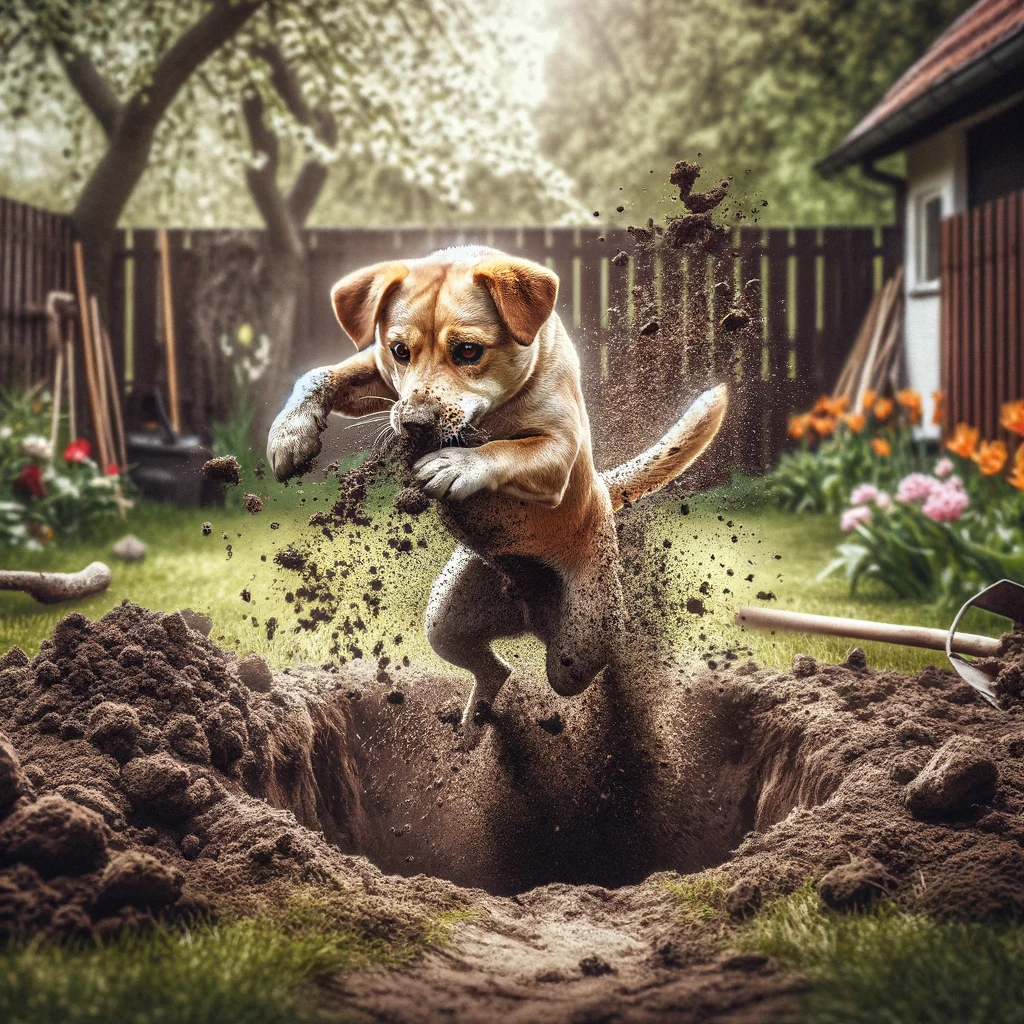Bringing home a new puppy is an exciting journey filled with cuddles, playtime, and the process of house training. As responsible pet owners, we aim to teach our furry friends where and when it’s appropriate to go to the bathroom.
House training is a vital part of a puppy’s development, ensuring a clean home and a well-adapted companion.
It’s a task that requires patience, consistency, and the right strategies. These strategies should be tailored to your puppy’s age and learning ability.

We quickly discover that puppies thrive on routine. Feeding, exercise, and potty breaks at set times each day establish a framework that facilitates faster learning.
While hiccups in the process are normal, we tackle each challenge with solutions backed by experience and understanding. Puppies can have accidents, but with a clear plan and plenty of positive reinforcement, we can guide them toward becoming well-behaved companions.
Key Takeaways
- Consistency and routine are foundational to successful house training, helping puppies understand and adapt to expectations.
- Understanding and responding to a dog’s signals for needing to go potty are crucial for timely and effective house training.
- Positive reinforcement, including treats and praise, significantly enhances the learning process, encouraging desired behaviors.
- Crates serve as an invaluable tool in house training, providing a sense of security for the dog and aiding in developing control over their elimination habits.
- Addressing behavioral issues and consulting professionals when necessary can overcome challenges, ensuring house training success even in difficult cases.
Puppy Development And House Training Basics
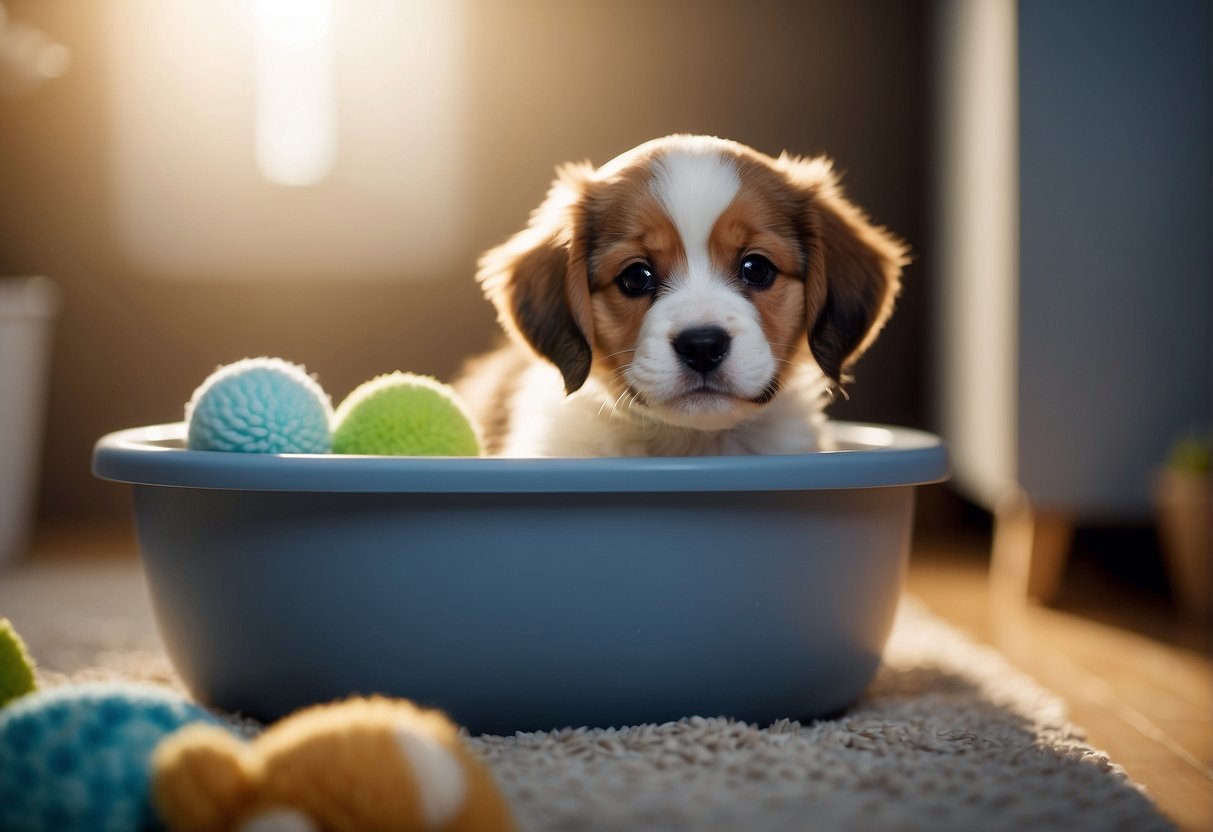
As we explore the intricacies of house training, let’s acknowledge the pivotal role that a puppy’s developmental stage plays in this process. Early conditioning, understanding the nuances of canine communication, and adapting to age-specific training milestones form the bedrock of effective house training.
The Significance Of Consistency And Routine
Consistency is the cornerstone of house training. We suggest you introduce and adhere to a strict schedule for feeding and potty breaks to instill a sense of routine in our puppies.
This structure helps young dogs develop habits and expectations, reducing accidents and increasing the likelihood of successful training.
For example, feeding our puppy at the same times each day and immediately offering a trip outside encourages associating relieving themselves with being outdoors.
Understanding Your Dog’s Signals
Interpreting our puppy’s signals is fundamental to timely and effective house training. Our pooches have their own unique ways of communicating their needs, particularly when it comes to potty time.
In case you’ve never heard the terms before, elimination disorder or inappropriate elimination is when a dog urinates or defecates in their owner’s house. Elimination is when a pup does so in a designated area.
By familiarizing ourselves with these cues, we can better respond to their needs and prevent accidents in the home. Common signs a puppy may exhibit when needing to go include:
- Circling: Your puppy may start to circle or pace in a specific area, indicating their need to relieve themselves. This behavior is often accompanied by sniffing the ground.
- Sniffing: Intense sniffing, particularly in areas where they have previously eliminated, is a strong indication that your puppy needs to go potty. They may be searching for a suitable spot to do their business.
- Whining or Barking: Some puppies may vocalize their need to go by whining, barking, or even scratching at the door. This is their way of alerting you that they need to go outside.
- Heading Towards the Door: If your puppy starts to move towards the door or the area where they typically go potty, it’s a clear sign that they need to go. They may even sit or paw at the door to further emphasize their need.
- Restlessness: If your puppy suddenly becomes restless or stops playing, it could be a sign that they need to go potty. They may appear distracted or unable to settle down.
By acknowledging these signals and immediately guiding your puppy to their designated potty area, you reinforce the proper behavior and prevent mishaps indoors.
Consistency is key in house training; every time your puppy successfully eliminates in the appropriate place, praise them enthusiastically and offer a treat. This positive reinforcement will help them associate the act of going potty with the designated area, making the training process more effective and efficient.
Age-Related Training Milestones
Puppies mature at different rates, and house training success hinges on aligning our expectations with their developmental capabilities.
Generally, a puppy gains better control over their bladder and bowels around the age of 5 to 6 months. Prior to this, their limited muscle development makes frequent outings necessary.
Adjusting our training techniques to match these age-related milestones ensures our puppies stay on a trajectory towards fully learned house training habits.
Effective Potty Training Strategies
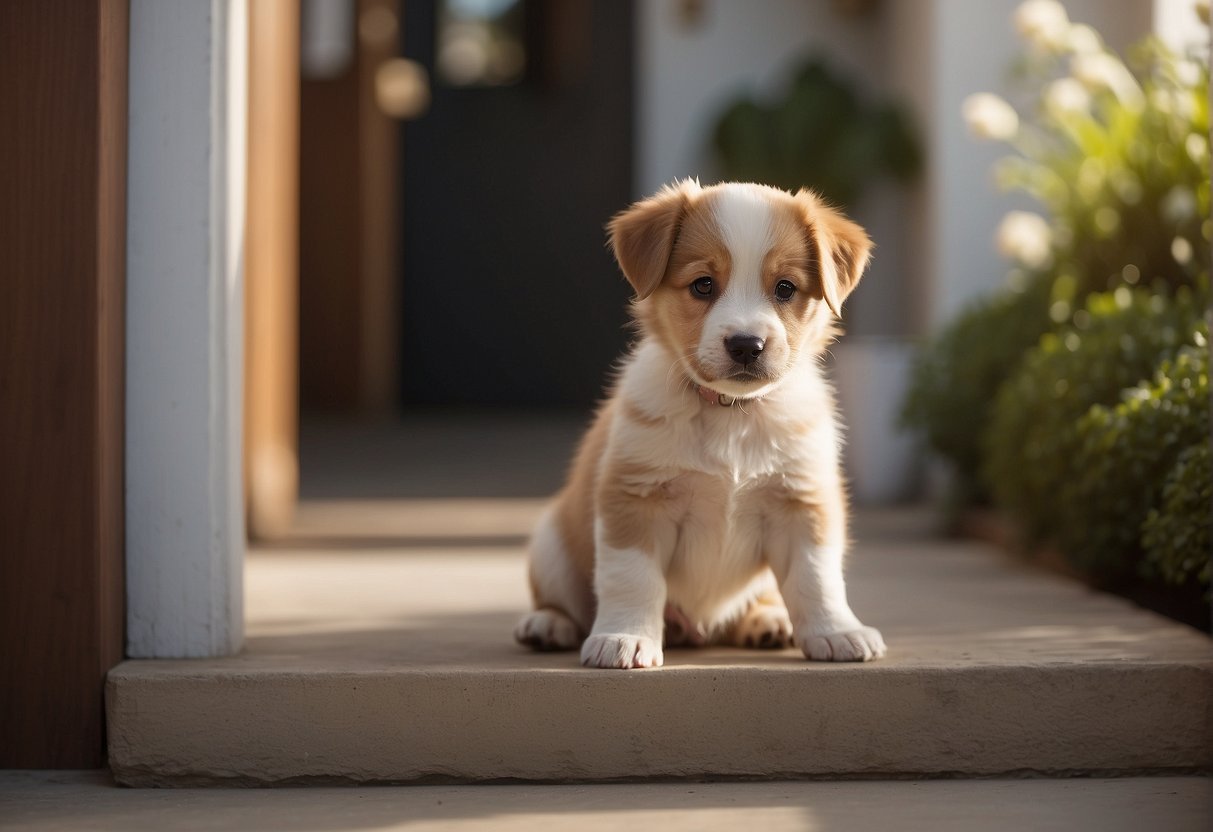
When we approach potty training, our focus is on establishing a clear routine, using positive reinforcement, and handling accidents strategically to ensure the process is as efficient as possible.
Utilizing Positive Reinforcement Techniques
Positive reinforcement is a cornerstone of successful potty training. This approach focuses on rewarding desired behaviors, such as eliminating in the appropriate location, to encourage the puppy to repeat these actions in the future.
By consistently offering praise and treats when your puppy goes potty outside, you create a strong positive association with the behavior, making it more likely to become a habit.
Here’s a quick breakdown of how to effectively use positive reinforcement in potty training:
- Immediately after elimination: As soon as your puppy finishes eliminating in the designated outdoor area, offer a high-value treat and verbal praise. The timing is crucial—you want your puppy to associate the reward with the specific action of going potty in the right place.
- Be consistent: Reward your puppy’s correct potty behavior every single time. Consistency is key in creating a strong association between the action and the positive outcome. If you only reward sometimes, your puppy may become confused about what you expect from them.
- Use enthusiastic verbal praise: In addition to treats, use a happy, excited tone of voice to praise your puppy. Words like “good boy/girl!” or “great job!” can be very effective in reinforcing the desired behavior. Your puppy will learn to associate your positive voice with the act of going potty outside.
- Gradually phase out treats: As your puppy becomes more consistent in their potty habits, you can start to gradually reduce the frequency of treat rewards. However, always continue to offer verbal praise and occasionally surprise your puppy with a treat to maintain the positive association.
- Avoid punishment: Never punish your puppy for accidents inside the house. Punishment can lead to fear and anxiety, which may actually increase the likelihood of inappropriate elimination. Instead, focus on redirecting your puppy to the proper potty area and rewarding them when they get it right.
By utilizing positive reinforcement techniques, you not only teach your puppy the appropriate place to eliminate but also foster a trusting and loving relationship.
Your puppy will learn to look forward to potty time as a chance to earn rewards and praise, making the training process more enjoyable for both of you.
Remember, every puppy learns at their own pace, so be patient and consistent in your approach. With time and positive reinforcement, your puppy will develop reliable potty habits, and accidents will become a thing of the past.
Managing And Reducing Accidents Indoors

Managing and Reducing Accidents Indoors: A Proactive and Positive Approach
Despite our best efforts, accidents happen during the potty training process. It’s important to remember that puppies are learning and may not always make it to their designated potty area in time. Our goal is to reduce these incidents over time through a proactive and positive approach.
Here’s how we can effectively manage and respond to indoor accidents:
| Strategy | Description |
|---|---|
| Catch them in the act | If you see your dog beginning to eliminate inside, interrupt them and immediately take them outside. Praise and treat if they finish outside. |
| Clean up effectively | Use an enzymatic cleaner for pet messes to remove odors and avoid ammonia-based cleaners, which resemble urine smell. |
| Adjust your supervision | Increase supervision by keeping your puppy in the same room or using baby gates to prevent unsupervised access to areas. |
| Stick to a schedule | Maintain a consistent feeding and potty schedule, taking your puppy outside at regular intervals, especially after meals, naps, and play. |
| Avoid punishment | Punishment after the fact is not effective and can harm the training process. Clean up accidents without scolding. |
| Celebrate successes | Offer enthusiastic praise and a treat every time your puppy eliminates in the appropriate spot, reinforcing positive behavior. |
Remember, potty training is a process, and accidents are a normal part of that process. By using a proactive and positive approach, you can help your puppy learn where it’s appropriate to eliminate and reduce the frequency of indoor accidents over time.
Potty Training Puppies vs. Adult Dogs
Potty training puppies and adult dogs may differ slightly, but the key principles remain the same. Let’s explore the differences and similarities to help you successfully train your furry friend!
Puppies:
- Need more frequent potty breaks (every 1-2 hours)
- Require close supervision to prevent accidents
- Reward with praise and treats immediately after successful potty trips
Adult Dogs:
- Can start with a more established potty schedule
- May have previous habits or fears to address
- Reward success and be patient during the training process
For both puppies and adult dogs:
- Establish a consistent daily routine for potty breaks
- Watch for signs they need to go (pacing, sniffing, circling)
- Use positive reinforcement to encourage the desired behavior
Remember, every dog is unique and will progress at their own pace. With consistency, patience, and lots of love, you’ll have a potty training pro in no time!
Establishing A Feeding And Exercise Regimen
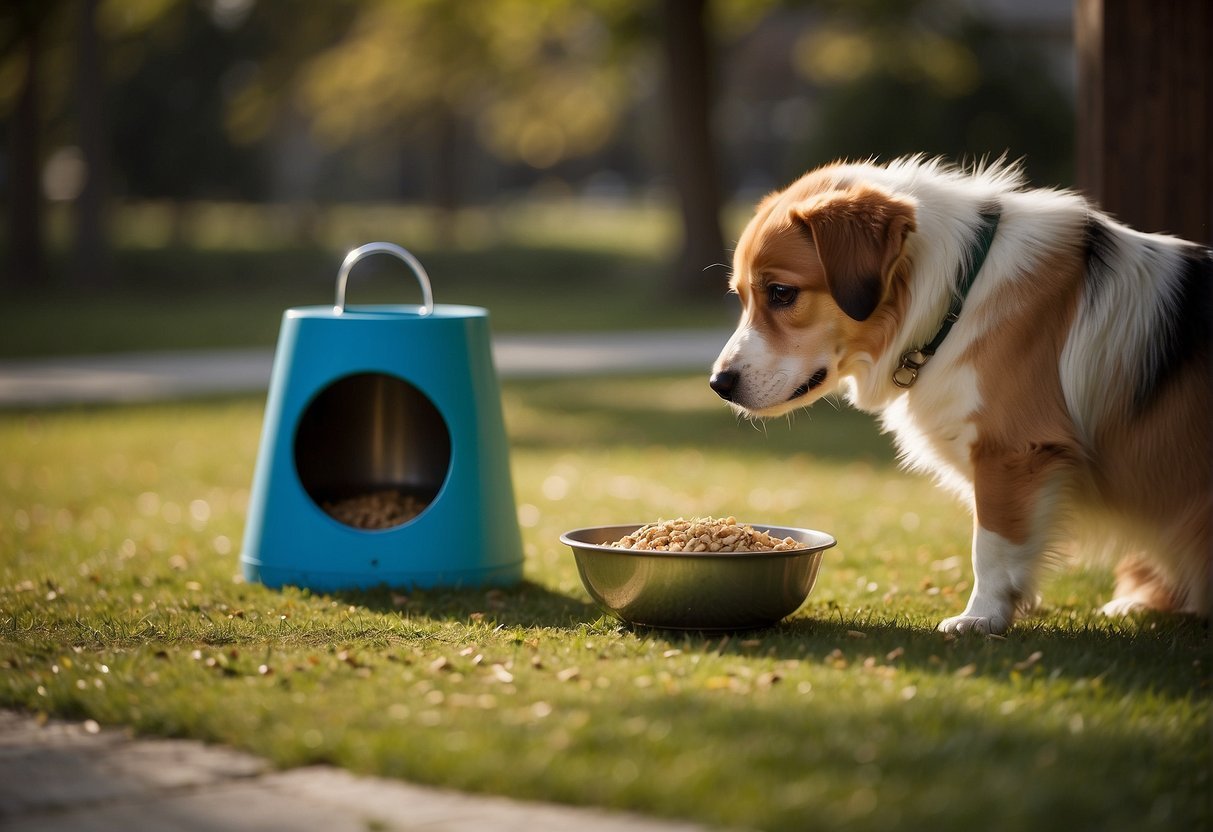
As we approach house training, we recognize the importance of a reliable feeding and exercise regimen in promoting timely elimination habits. Here, we’ll explore the powerful role nutrition plays and how to balance vigorous play with structured training sessions for optimal success.
The Role Of Nutrition In House Training
Nutrition is foundational for effective house training. Establishing a consistent feeding schedule is important, as it leads to predictable elimination patterns.
We recommend:
- Feeding our dogs twice daily at the same time.
- Using high-quality food that meets nutritional needs, which can reduce the frequency of bowel movements.
By maintaining a set routine, we can reliably predict when our dog will need to eliminate, which is key in preventing accidents around the house.
Balancing Playtime And Exercise With Training
Exercise and play are integral to house training, but must be managed wisely. We suggest the following:
- Schedule playtime shortly after feeding and elimination. This practice not only helps with digestion but also ties rewarding play with successful elimination.
- Incorporate exercise into the routine to ensure our dogs are adequately stimulated, both mentally and physically. A tired dog is typically a well-behaved dog.
Regular, structured exercise helps dogs avoid restlessness and anxiety, which can lead to indoor accidents. By balancing play with training, we harness a dog’s energy and turn it into an opportunity for learning and growth.
Essentials Of Crate Training
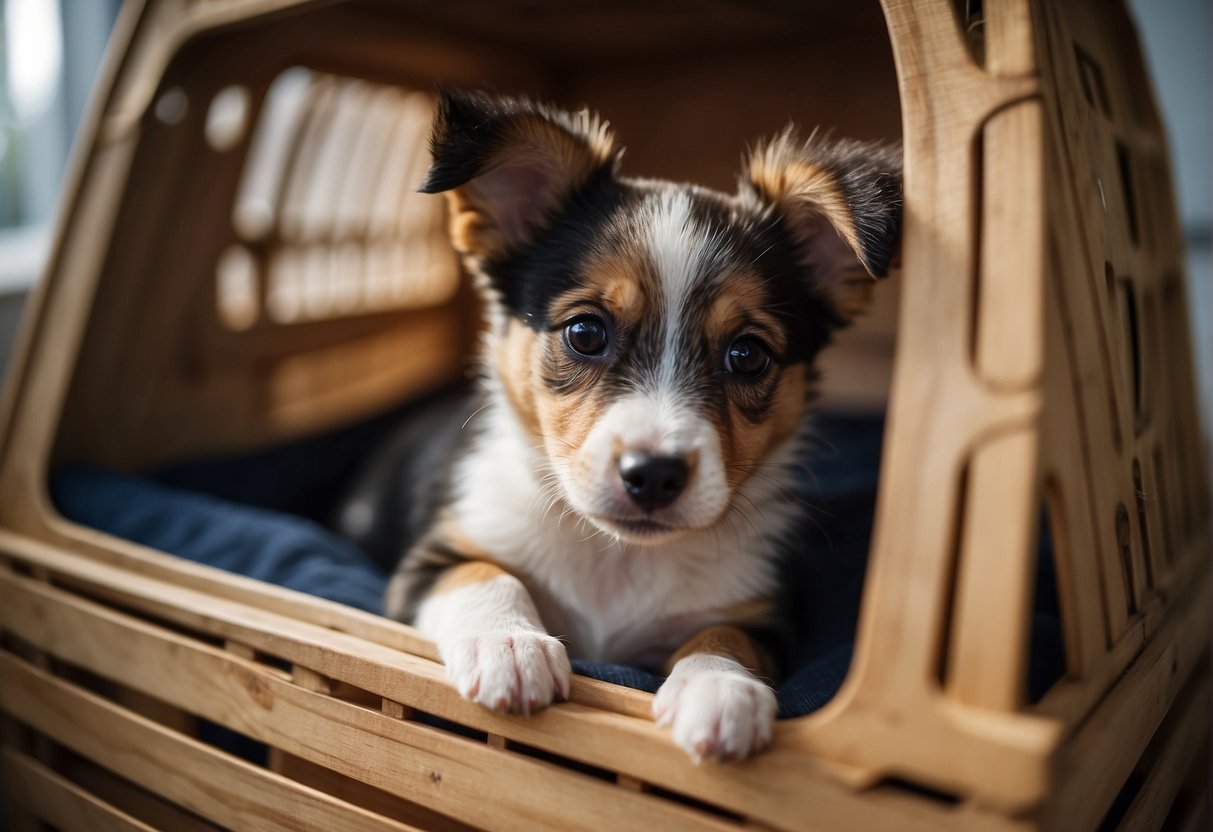
Crate training leverages a dog’s instinctive desire for a ‘home’ as den animals to provide a safe space and aid in house training. Properly introducing and using a crate can be beneficial for both the dog and owner.
Creating A Safe And Comfortable Crate Environment
To ensure your dog views the crate as a safe haven, selection and setup are key. Choose a crate that’s large enough for your dog to stand, turn around, and lie down comfortably.
A welcoming crate should include a soft blanket or bed, which can help entice your dog to enter voluntarily.
Additionally, placing the crate in an area where we spend a lot of time makes the crate an integrated part of their social environment.
Integrating Crate Training With Housebreaking
We use crate training as a foundational element of house training. Since dogs naturally avoid soiling their sleeping quarters, we can use the crate to establish a routine and prevent accidents.
To incorporate this, we may feed the dog inside their crate to reinforce that it is their space, as suggested by the American Kennel Club.
Remember, the crate is a training tool, not a place for long-term confinement. The goal is to create positive associations, ensuring that the dog feels secure and content within their own space.
Common Challenges House Training Your Dog
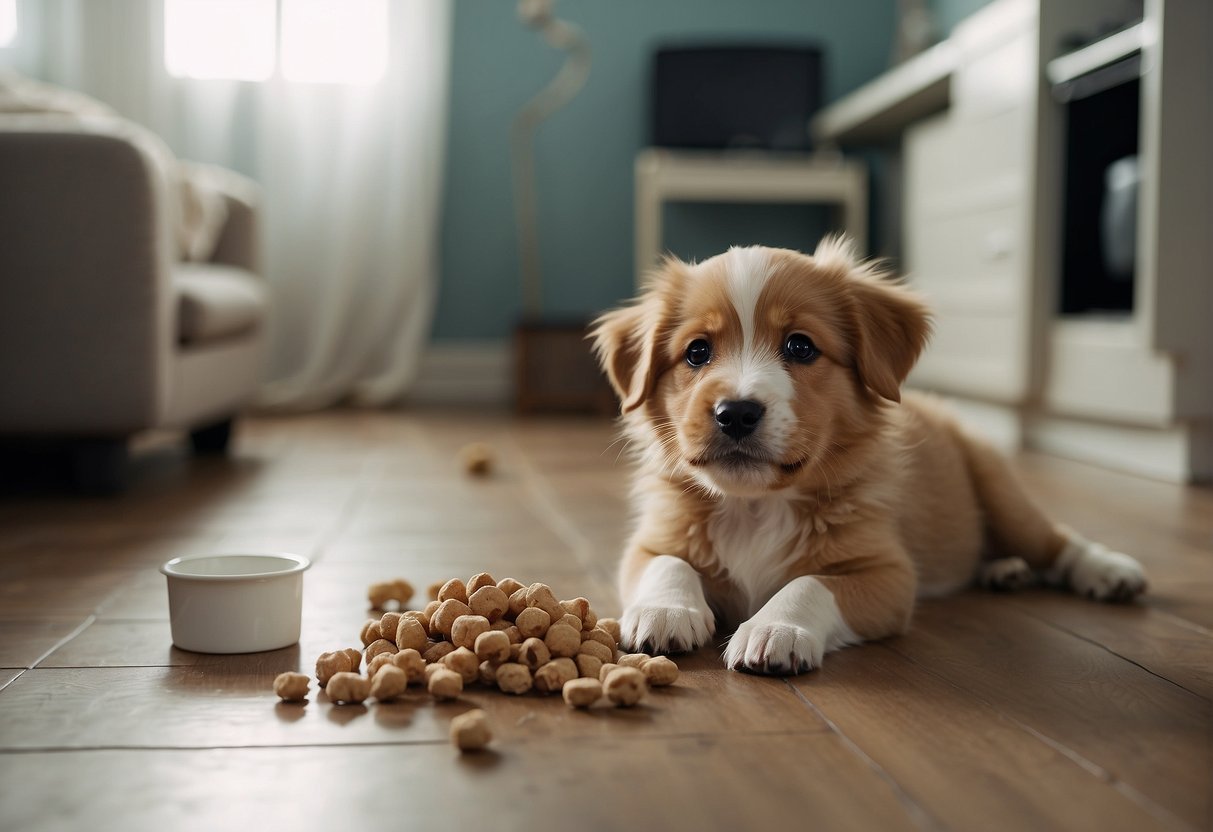
Addressing Behavioral Issues And Anxiety
Behavioral Issues: Dogs may exhibit behavioral problems such as aggression, excessive barking, or destruction.
One common issue is house soiling, where a dog repeatedly eliminates indoors. This can stem from anxiety, lack of proper training, or habit.
To address this, we must reinforce positive behaviors using treats and praise. We should also maintain a consistent schedule for meals and elimination.
It’s crucial to avoid punishment after accidents, as this can increase anxiety and make the issue worse.
For successful training:
- Consistency: Establish and stick to a routine.
- Positive Reinforcement: Reward desired behaviors immediately.
- Neutral Responses: To discourage accidents, clean up without displaying anger.
Identifying signs of stress, such as pacing or whimpering, allows us to take proactive steps to create a calm environment.
Solutions might include:
- Providing a safe space such as a crate or quiet room.
- Gradual desensitization to stressors.
- Exercise and mental stimulation to reduce anxiety.
Consulting Professionals For Difficult Cases
Sometimes, despite our best efforts, behavioral issues persist or a dog may have a medical condition influencing their house training, such as a urinary tract infection. Seeking professional help can help clarify and hone in on the specific needs of our pup.
Here are steps we take if our efforts don’t yield the desired results:
- Professional Dog Trainer: Enlisting the help of a professional can provide tailored guidance for our dog’s unique issues.
- Veterinary Checkup: If we suspect a medical issue, a thorough veterinary examination is crucial. Conditions like bladder infections or hormonal imbalances can lead to accidents. For example, neutering or spaying can sometimes mitigate house soiling behaviors linked to hormonal urges.
- Patience: We understand that resolving house training issues might take time, and patience is key. Each dog progresses at their own pace, and we are prepared to adjust our approach as needed.
Conclusion

Bringing a new puppy into your life is a heartwarming adventure, and mastering house training is one of the first exciting steps you’ll take together.
It’s all about getting to know your pup’s needs, setting a routine, and showering them with positive vibes and little rewards. Think of house training not just as a must-do but as a wonderful chance to grow closer, turning every little hiccup into a learning moment filled with love and laughter.
Sure, there might be a few slips along the way—some accidents here, a behavioral quirk there—but that’s just part of the journey. If things get tricky, there’s always professional help to guide you through.
With a sprinkle of patience and a heap of affection, you’re on your way to nurturing a joyful, well-behaved pal. Together, you’ll not only build a spotless home but also forge an unbreakable bond that lasts a lifetime.



